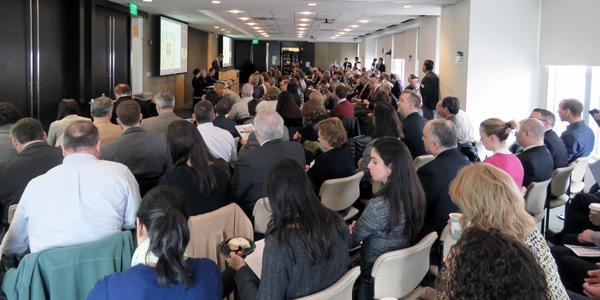By Michael Kuser
BOSTON — The nation’s smallest state doesn’t get to crow very often. But at the New England Restructuring Electricity Roundtable on Friday, Commissioner Carol Grant of Rhode Island’s Office of Energy Resources basked in applause as moderator Jonathan Raab said the state deserved to take a “victory lap” for putting into operation the first offshore windfarm in the U.S.
Not just the U.S., Grant corrected: “The first in the Western Hemisphere.”
The 30-MW Block Island Wind Farm, which began commercial operations in December, is a small step toward meeting the state’s “strategic goal” of 1,000 MW of “clean energy” by 2020, announced by Gov. Gina Raimondo on March 1. The state currently is little more than one-tenth of the way, with 138 MW operational, Grant said.
Although the governor’s challenge is not a legislative mandate, Grant said the legislature has enacted policies that will get Rhode Island halfway to the goal.
“The success of the Block Island Wind Farm is a big help in persuading people that anything is possible,” she said. “The reason we’re really fortunate in this region is that we actually have the ability to collaborate across states. In a small jurisdiction like Rhode Island, that helps because there’s brain power just across the border to the north.”
Grant joined Massachusetts Secretary of Energy and Environmental Affairs Matthew Beaton and Connecticut Deputy Commissioner for Energy Mary Sotos in briefing an audience of policymakers, stakeholders and analysts on how their states are attempting to transition to clean energy with minimal market disruption.
“I wouldn’t underestimate how much the rest of the country looks to New England for our experience in renewable energy and a lot of this thought leadership, experience with regional gas transmission,” Sotos said.
“The core of our energy strategy boils down to three elements: cost, carbon and reliability,” Beaton said. “We have some of the highest costs in the nation and we have to be cognizant of that in the commonwealth. … We have some of the most aggressive carbon reduction goals, the legislature having mandated a 25% reduction by 2020 and 80% reduction by 2050.”
After his presentation, Beaton left for a meeting with Gov. Charlie Baker, while his deputy, Undersecretary Ned Bartlett, stayed behind to answer questions. The first came from Raab, who asked for the main ingredients in the “secret sauce” for a sustainable renewable energy policy. Bartlett answered that “the challenge is to bring the reality of time-differentiated pricing into the solar market,” adding that open and inclusive markets create choices.
ISO-NE Previews Economic Study
A second panel at the roundtable featured Bob Grace, president of consulting firm Sustainable Energy Advantage; Jamie Howland, director of climate and energy analysis for the Acadia Center think tank; and Michael Henderson, ISO-NE director of regional planning and coordination.
Henderson presented a draft version of the RTO’s 2016 Economic Study, soon to be finalized before the grid operator’s Planning Advisory Committee. Phase I of the report analyzes production costs and related metrics, while Phase II discusses several market and operational issues.
Henderson referred his listeners to “a lot of great work being done by the U.S. Department of Energy, and particularly [the National Renewable Energy Laboratory], in modeling what the ISO needs to use in terms of wind and photovoltaics. A lot of those databases are essential to the planning process. But I leave it to you and the developers to come up with the costs. We don’t do that at the ISO.”
Responding to Henderson’s slideshow, Richard Levitan of Levitan & Associates asked, “It looks like there’s an annualized transmission [cost] of $1.5 [billion] to $2 billion to accommodate the build of clean energy and green energy in northern New England. … That transmission result [locks] onshore wind in northern New England.”
Henderson acknowledged that a “very, very large-scale wind development” in northern New England would require a “quite expensive” transmission expansion. “To facilitate it in some of the first steps, the ISO is doing a number of cluster studies now where we’re looking at inputs on the order of 2,400 MW in the north country. … Whether or not it’s economical — the way we want to go in the region — [I] leave that for others: someone who wants to consider policy, costs or metrics other than what we considered in this report.”
Grace used his own metrics to show the increase in renewable supply entering the New England market. “This is the wind projects coming online, this is increasing imports, this is biomass refurbishment. It’s a lot of different things hitting us at once, but it puts us in a new place.”
Howland discussed the potential of incorporating distributed resources into planning through “active load management, which is our term … for smaller-scale demand management that is more flexibly dispatched and automatically dispatched.
“So it could benefit hot-water heaters … and then energy storage in the region,” he said.
The last question of the day went to Henderson: Have you looked at the effect of pricing pressure from solar and wind?
Henderson said the RTO’s analysis found that even with a large-scale development of renewables, “there are still very, very, very significant periods of time when natural gas remains on the margin” in the region.
The analysis also showed renewables on the margin, particularly in light-load periods like May. “And by the way, all that load occurred in the middle of the day, so … there were many days when [energy storage] would be feeding the network at night and drawing from the network during the day, which is kind of the opposite of the way we think of storage operating today,” Henderson said.
